I knew I would probably like Hollow Knight from the start, but I was not at all prepared for it to resonate with me as much as it did. With the release of Bleed 2 last month and with virtually guaranteed heavy hitters like Iconoclasts and La-Mulana 2 on the horizon, 2017 is an incredibly exciting year for indie games, yet Hollow Knight may very well end up as my favorite game of the year. With a massive world to explore, an outright ridiculous number of secrets, a combat system which manages to feel extremely fluid while giving each and every attack a sense of weight, and an atmosphere which seamlessly combines some good old-fashioned Dark Souls gloom with lighthearted humor, this is one experience which is far from empty.
Taking on the role of a nameless bug wielding only a worn, sword-like ‘nail’, you begin your descent towards the derelict city of Hollownest and its surroundings by plummeting from a cliff. After a rough landing, the game wastes no time before introducing players to combat and the Focus system. Soul energy is this game’s version of MP and it is represented by a glowing white liquid which gradually fills up a container, the ‘soul vessel’. You accumulate some energy every time you slash an enemy and it can also be harvested from certain statues in the environment, so it doesn’t take long at all to replenish your supply. Other than resting at a checkpoint bench or in a hot spring, focusing is your only way to recover lost health and it consumes about a third of the soul vessel’s capacity per point healed. Focusing can be used at any time, even in the middle of combat, but you can neither move nor attack while focusing, making it particularly risky to use while facing a fast opponent or multiple foes. The soul energy required to heal is gradually drained while focusing as well, so getting knocked out of it by an attack or simply stopping early to avoid an attack results in a loss of energy with no gain. In general, the nature of the Focus system makes it so that dying while exploring is rare because you’ll generally encounter enough weaker enemies to keep your soul vessel filled, but boss fights remain intense as they rarely provide enough opportunity to do anything beyond occasionally recovering a single point of health.

As a general rule of game design, faster combat systems have a sense of intense fluidity as players rapidly weave together dodges and attacks while slower, more deliberate combat systems benefit from a sense of weight where the impact of every hit can be clearly felt. Hollow Knight ignores this rule and instead presents players with a combat system where players can attack swiftly and have plenty of mobility without sacrificing the sense of weight behind every hit. This blending of the best of both worlds is in part accomplished through the excellent attention to aesthetic details as every hit is accompanied by a satisfyingly visceral slicing sound while globs of corrupt yellowish-orange blood fly through the air. Likewise, striking a shield or a similarly impenetrable surface results in a sharp clang. Hits inflicted upon the player feel particularly weighty as time briefly pauses, the music becomes quieter and distorted, creating the impression of being underwater, and a strange black mist escapes from the protagonist in place of blood. However, the biggest factor when it comes to giving combat a sense of weight without sacrificing speed is Hollow Knight‘s rather clever usage of knockback.
I don’t think I’ve ever seen a game use knockback mechanics as effectively as Hollow Knight. The impact of your attacks affects each enemy different with larger enemies not budging an inch while smaller enemies and flying enemies can be shoved away for better are worse; attacks from above or below tend to be especially effective at launching aerial enemies far away. You likewise suffer some knockback when you get hit, though it’s a small amount which rarely matters unless you’re near some spikes or are in a more vertical area where you might get knocked off a ledge. What makes this particular knockback system stand out so much though is the fact that your own attacks push you backwards. On top of serving as a great way to convey to players the sense of impact behind each of their slashes, this system has a significant effect upon the gameplay itself. While on the ground, this means that you need to always be aware of any hazards or enemies behind you as your own attacks can knock you into them and you can never stand still for long as, even though you are only knocked back a small amount with each slash, the gap between you and your target will eventually grow wide enough that you’ll need to manually readjust yourself.
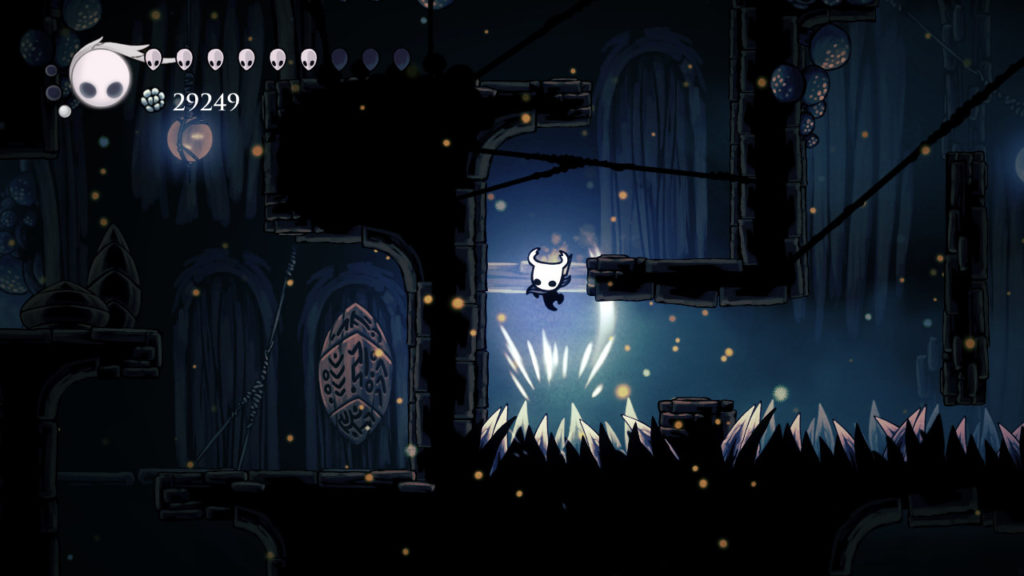
The importance of this system becomes much more obvious once you’re in the air as slashing at an enemy below you bounces you upward. Several enemies, particularly those found early on, have no way of defending themselves against attacks from above so you can safely deal with them this way as long as you keep up your rhythm; slashing too early or too late will result in colliding with the enemy and taking damage. This also allows for a more aggressive style of play as you can slash at an enemy from the front, jump over its counterattack, and then bounce off of it from above before landing a third slash from behind. Enemies which wield shields virtually demand that players get used to making use of the downward attack’s bounce as they can reorient their shields quickly enough to block most of your attacks unless you are constantly on the move. In fact, this aerial knockback is an outright mandatory skill to learn because you can bounce off of enemies, even invincible ones, to reach higher places and you can even bounce off of spikes with your attacks to save yourself from taking additional damage after being hit towards spikes by an enemy or to cross spike-filled gaps. Whether you’re in combat or using your nail for platforming purposes, your attacks and movements begin to take on a steady rhythm rather than simply being fast.
Even though the only abilities you begin with are slashing and focusing, the list of powers at your disposal constantly expands. You gain access to various mobility upgrades, though the earliest and most game-changing ones are the dash and wall jump. Both of these abilities greatly increase your mobility to allow for even more fluid combat and many areas become accessible once you have them, though the average difficulty of most new enemies and platforming challenges noticeably increases to take this power boost into account. Three attack spells which use up soul energy are also scattered across the game and the first of these, a cannon-like blast of soul energy in a straight horizontal line, is particularly helpful due to its long range. As for melee attacks, your basic slash is always going to be your primary way of dealing damage, but there are also three stronger attacks you can acquire which need to be charged up (you can move while charging unless when focusing though). Despite all these active abilities, your strongest tool when it comes to complementing your playstyle comes in the form of passive charms.
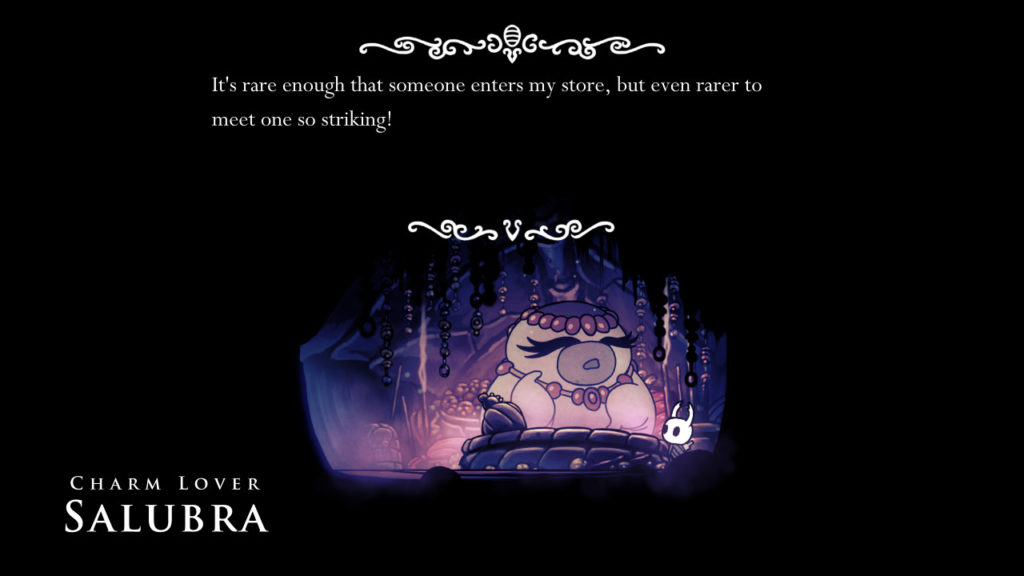
There are well over 30 charms to find in the game and not a single one is useless. Charms can only be swapped around at benches and charms can cost anywhere from one to five charm notches to equip. You only start with three notches and chances are high that you’ll want to use one of those for the Wayward Compass charm, which shows your position on the map, so your options are rather limited early on, but your options expand once you get another notch or two and by the end of the game you can experiment with hundreds of combinations. Want to focus more on magic attacks? Charms exist for boosting the amount of soul your attacks generate and for increasing the damage and reducing the cost of spells. If you want to try healing in boss fights you can use charms to reduce the time focusing takes while also giving yourself the ability to move slowly while doing so, but if a boss is simply too fast you can try out charms which give you some blue, unrecoverable health points. Personally, I prefer a more mobile, melee-oriented style so I always used the Dashmaster charm, which eliminates the cooldown period between dashes, and usually included charms which boosted the speed and length of my basic slashes. Many charms can be purchased from NPC’s, but plenty of them can only be found by navigating through tough platforming challenges or fighting optional bosses. There are also several cases where two charms have the same basic effect, but one is stronger at the cost of more notches, so you can choose between power or versatility or even just equip both at once if you really want to double down on a specific benefit. With charms, every tough fight becomes a puzzle where losing just means getting the chance to figure out the best charm combination for the job.
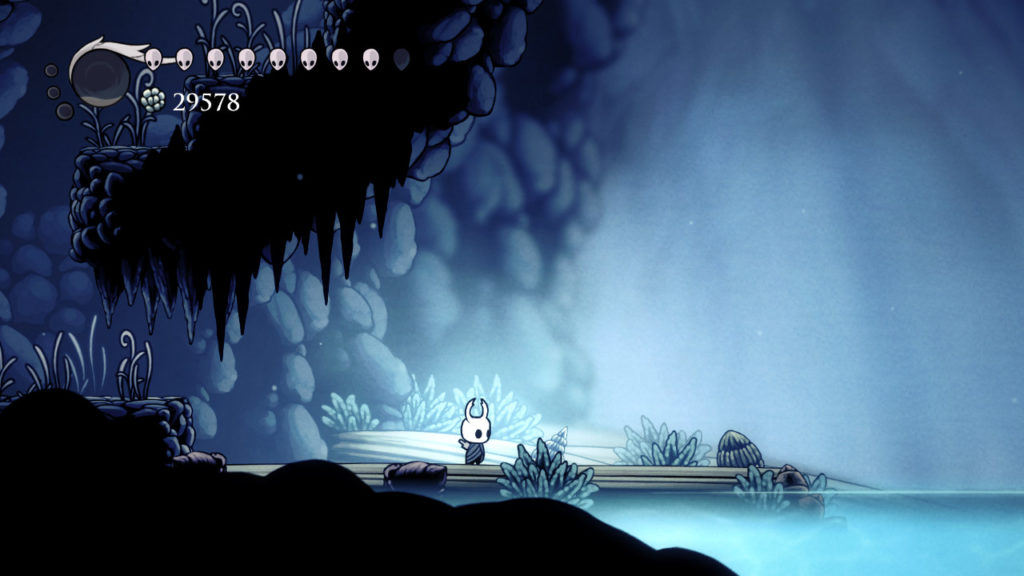
The world of Hollownest is astonishingly large and exploring it is a wonderfully freeform experience. Sure, the very beginning of the game is fairly linear aside from a few side rooms and fake walls, but once you get some basic upgrades it really opens up. You’re never forced to go anywhere and even when you’re given a general idea of where to go or what to do next there are inevitably plenty of other places you are free to explore instead. This isn’t a standard Metroidvania where each new ability really only unlocks a specific area and the sense of freedom is largely only an illusion, this is a game where you can often stumble upon two or three wildly different paths which eventually meander their way towards the same general part of the map and even more paths which branch off into different areas entirely. There were many times during my playthrough where I would have a specific goal in mind only to be diverted away from it for hours as a ‘small side area’ along the way turned into a path leading to areas I didn’t even know existed. As a $15 game from a small indie studio I expected Hollow Knight to have about 15 hours of playtime at the absolute most and again and again I would come to a point where I thought I must be approaching the end only to unexpectedly gain access to two or three entirely new areas as well as dozens of paths in old regions which I had long forgotten about; I didn’t see the credits roll until about the 30 hour mark and it took even longer than that for me to at last earn a 100% completion rate.

Not only is Hollownest massive, it’s absolutely beautiful and its regions are extremely varied. From the thriving plants of Greenpath to the beautiful architecture of the central City of Tears and the dark, claustrophobic tunnels of Deepnest, every region is unique with an exquisite attention to detail. The enemy variety is equally impressive with nearly 150 types including bosses and only a few appear in more than one region. Entering a new area doesn’t just mean a change of scenery, it means confronting an entirely new set of enemies and hazards. Enemies are also each designed with their respective regions in mind. For example, Greenpath is filled with all sorts of camouflaged enemies like giant Venus flytraps which can grow on any surface and only show their teeth while hidden and all sorts of enemies of varying sizes which are covered in leaves and try to sneak up on you. Meanwhile, the City of Tears is filled with the animated husks of humanoid bug guards and nobles which have fallen prey to the mysterious infection which led to the fall of Hollownest and many of the enemies in Deepnest would undoubtedly give nightmares to anyone afflicted with arachnophobia.
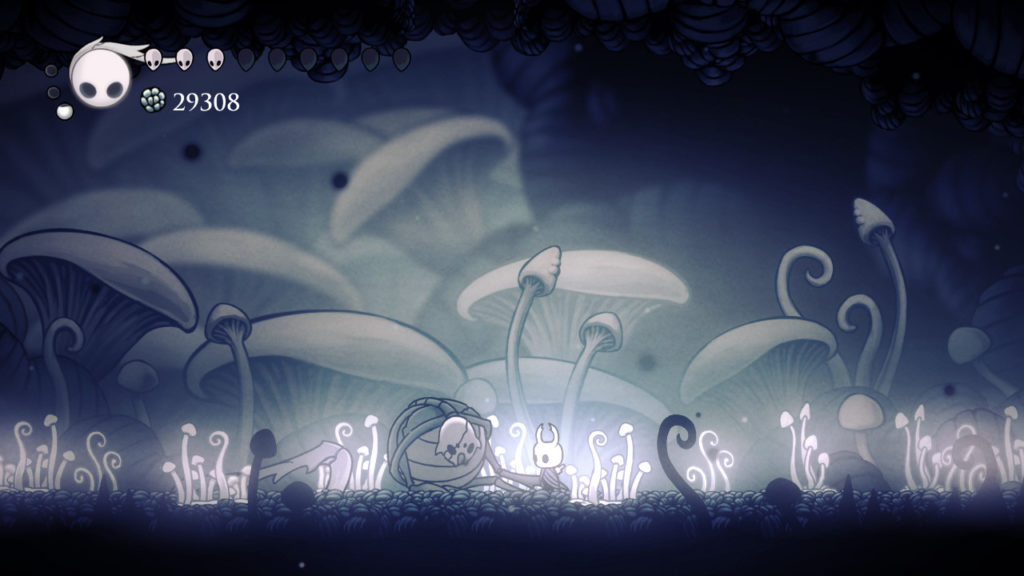
There are all sorts of things to discover while exploring and the act of exploration itself is a bit more involved than usual. Aside from charms, Mask fragments and soul vessel shards can be collected to boost your health and soul capacity respectively. dozens of grubs trapped in glass jars are scattered around and freeing them leads to many different rewards. The order in which you gain most abilities isn’t fixed either and it’s entirely possible to ignore a branch in the path early on only to come back to it hours later to discover that it leads to a crucial upgrade or at the very least a useful optional one. As to exploration itself, on top of needing the Wayward Compass charm equipped to see your location on the map, you need to find the map NPC in each area to buy an incomplete map of the region in the first place and then the protagonist fills in any uncharted parts they moved through every time they rest at a bench, including after being defeated. It’s a system which some might end up simply finding annoying or overly cumbersome, but I think it fits in well enough with the more freeform style of exploration.
If you care about the lore, monuments are scattered about with writing which hints at the backstory to each area and killing a certain amount of each enemy type will unlock some additional flavor text for it in the bestiary, though simply paying attention to the details of your surroundings is often enough to learn a great deal about a place. You also eventually gain access to the Dream Nail, which isn’t actually a weapon but rather a tool which can be charged up to see the thoughts of the various NPC’s wandering throughout Hollownest and even the more basic thoughts of any given enemy if you can line up the slash. Other than for lore purposes, the Dream Nail can collect a special type of energy which can be turned in for rewards in two different ways. First, you can use it on certain trees hidden around the map which will cause orbs to scattered about the room for a collection-based platforming challenge. Secondly, the Dream Nail can be used on the graves and corpses of deceased warriors to challenge them to fights and these optional boss battles range from simple and easy to incredibly difficult.
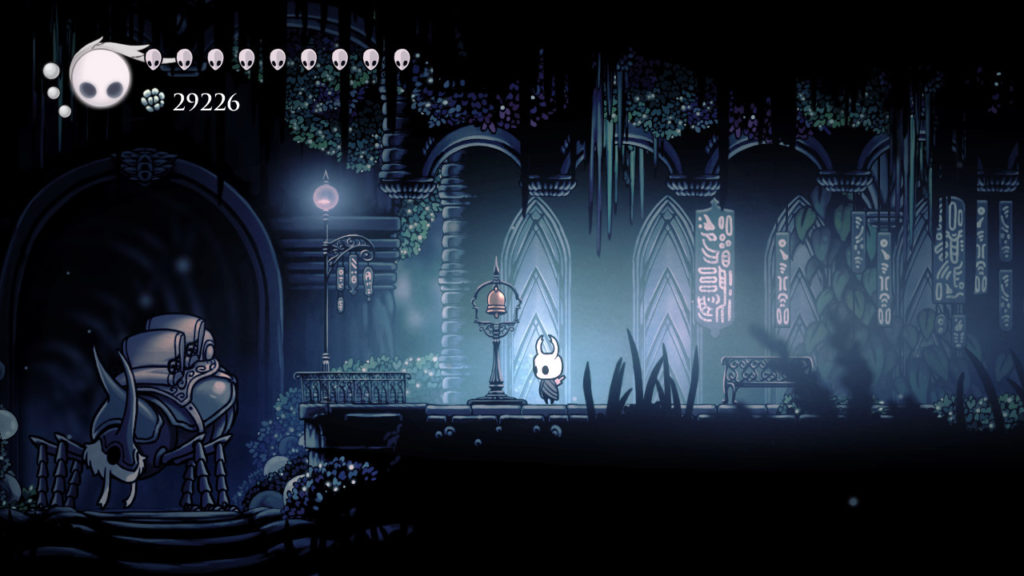
If there is one downside to Hollow Knight, it’s the backtracking. Most regions have a Stag Station in them from which you can summon a giant stag beetle to take you to another station. Unfortunately, these stations are not always positioned near the center of a region so if you want to check out a previously inaccessibly room (or one which you simply skipped on your first time through an area) you may very well have to run from one side of that region to the other or through half of a different region to get there. The worst offender is probably Deepnest as its large rooms with winding tunnels make it easy to miss areas and items while you’re still mapping it out, but the closest Stag Stations to the early parts of Deepnest are still far enough away that you’d need to either travel through a good chunk of the Fungal Wastes or through part of the City of Tears and one of two other areas, to say nothing of any rooms of Deepnest itself you may need to dash through to reach your destination. With no way to easily travel back to where you started from other than deliberately dying (and losing all your money in the process), you inevitably need to spend about as much time running back to where you started from as you spent getting there. The amount of backtracking you need to do is considerably lessened after your first time through the game since you’ll already be familiar with the map and where everything important is, but this is one instance where the freeform exploration works against the game’s favor as any given unfinished path on the map could be one which leads to a crucial upgrade or it could just as easily lead to a much smaller reward or something you still can’t actually reach. The Stag Stations are nice, but the game could really benefit from a way to easily warp back to the quaint starting town of Dirtmouth which has its own Stag Station and most of the vendor NPC’s as such a thing would virtually cut backtracking time in half.

Before wrapping things up, there is one last, somewhat unusual point which is worth discussing. Namely, Hollow Knight shares more than a few similarities with the Dark Souls games, but, and I really do want to stress this, at the end of the day it is very much a unique experience and not another game trying to be ‘2D Dark Souls‘. As far as similarities go, there are enough of them that it’s almost certainly not a coincidence. The risk involved in standing still to heal is virtually identical to that of using an Estus Flask in Dark Souls. Likewise, the penalty for death is rather similar as you lose all of your money, but you can get it back if you make it back to where you died and defeat a rather weak shadow version of yourself. The setting carries the same gloomy air of mystery as you travel through the sad remains of a once-prosperous land. Even the storytelling style is similar as little is told to you directly and you instead need to piece things together from bits and pieces of flavor text and brief snippets of conversation whenever you encounter the various NPC’s as the wander the ruins while going through their own short character arcs as the game progresses; every single character, including the silent protagonist, is far more familiar with the world than you are so they are not going to break out into giant globs of exposition.
However, at best you could argue that some elements are inspired by Dark Souls because as a whole this is a wildly different experience. There are no RPG elements like levels or stats to worry about and there’s no equipment to find other than charms and upgrades for your nail. The combat system is also completely different as even though there is often a rhythm to fights it is far from methodical. As far as difficulty is concerned, Hollow Knight is a game where players don’t need to constantly be on their guard – you can be a bit sloppy in combat and you can take risks while exploring because most threats only take off a single point of health and even the strongest attacks never take off more than two at a time; even when the game is at its hardest you can still recover from making a few mistakes. Even the healing system is just as much an alternative, more consistent take on farming enemies for health drops as it is an alternative to Estus Flasks. Last of all, even though the setting is a rather gloomy one, Hollow Knight isn’t focused on making its setting as depressing as possible; many of the NPC’s are quite cheerful and go through arcs which end well for them, a good deal of the dialogue is humorous or at the very least lighthearted, and even many of the enemy designs lean towards being gross, weird, or funny (or all three) rather than horrifying. I have nothing against games which seek to put their own spins on very specific formulas established by other franchises, but I think it’s important to be able to identify the difference between a game which seeks to mimic another and a game which incorporates some of the better elements from another without copying it wholesale.
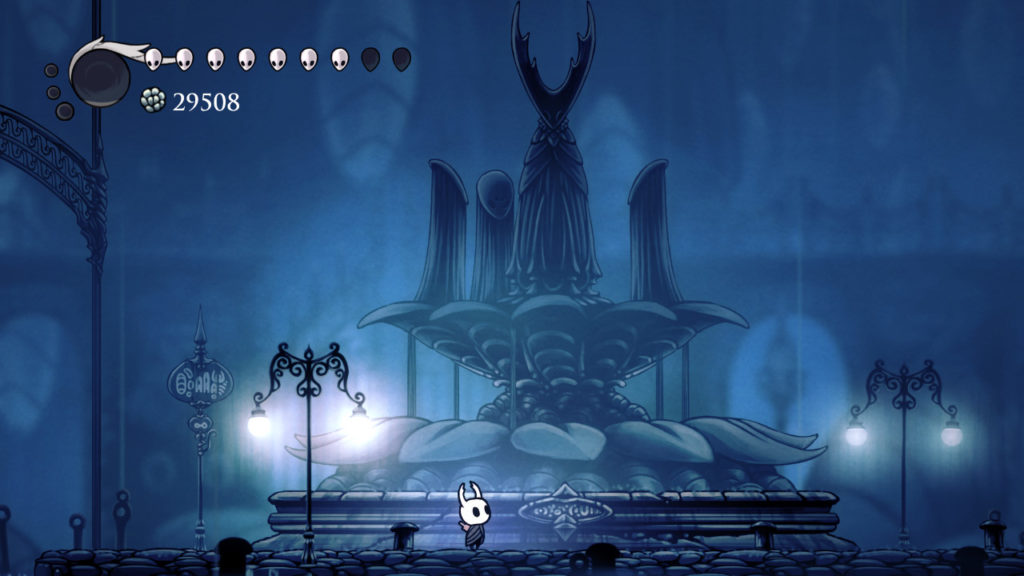
Hollow Knight is a truly incredible game and one which I will surely go back to. A bit too much backtracking is an astonishingly small price to pay at the end of the day compared to the quality of the game as a whole. This is a masterpiece which should go down in history as one of the great indie classics and I eagerly look forward to seeing what Team Cherry has in store for the future.